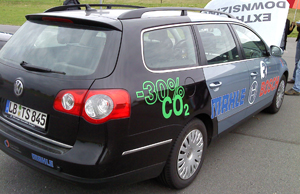
BOXBERG, Germany – There’s a new turbocharger player in town, ready to launch production in Austria of high-volume units to be used by a major German auto maker with gasoline and diesel engines at the end of this year, a Robert Bosch executive tells Ward’s.
The Bosch Mahle Turbo Systems joint venture cannot yet identify its first European light-vehicle customer.
But a second contract with German off-highway producer Deutz calls for turbochargers to be used in agricultural and construction equipment, as well as stationary power units. Production begins in May 2012.
In 2015, the JV expects to sell more than 2 million turbochargers, says Rolf Leonhard, Bosch executive vice president-engineering for diesel systems, at a press conference here.
“We are very successful with our technology, and the markets appreciate it,” he says.
Founded in 2008, the 50-50 joint venture has 200 employees and a plant in St. Michael ob Bleiburg, Austria.
Bosch and Mahle formed the JV after auto makers invited additional suppliers four years ago to enter a segment that has grown rapidly with the global popularity of common-rail diesel and gasoline direct-injection engines.
Integrating one or two turbochargers has become a standard method for many auto makers to downsize engines to reduce fuel consumption without sacrificing performance. The top turbocharger producers are BorgWarner and Honeywell (Garrett).

Here at Bosch’s test track, an ’09 Volkswagen Passat “Extreme Downsizing” demonstration vehicle has a new 1.2L 3-cyl. engine from Mahle Powertrain with a single-stage turbocharger from the JV.
And despite its diminutive size, the engine performs remarkably well in powering the spacious 5-passenger Passat wagon around Bosch’s high-speed oval at more than 112 mph (180 km/h).
With a manual transmission, the engine is a bit hesitant at launch, but throttle response is excellent at mid-range and high engine speeds, with a fat torque curve that peaks at 210 lb.-ft. (285 Nm) from 1,600 to 3,500 rpm.
Some vibration is noticeable in the driver’s seat, but in general the noise, vibration and harshness characteristics are acceptable, even though Mahle Powertrain engineers did not spend a lot of time isolating the engine on this prototype.
A casual driver would be unlikely to guess such a small engine is underhood.
The 1.2L engine is rated at an astounding 161 hp at 5,000 rpm, compared with 121 hp in the production engine it replaces, a 1.4L TSI direct-injection gasoline 4-cyl.

And mileage isn’t bad, either. Bosch pegs fuel consumption at 40 mpg (5.9L/100 km), based on the European driving cycle.
Maximum boost pressure of the demonstration single-stage turbocharger is 36 psi (2.5 bar). The prototype engine also integrates cam phasing on both intake and exhaust sides of the valvetrain.
Bosch supplies the engine controller, calibration and pressure sensor for the fuel rail.
Taking credit for the engine, itself, is Mahle Powertrain, which was formed in 2005 after engine specialist Mahle acquired Cosworth Technology and began pursuing a strategy for complete cylinder-head modules.
Cosworth had been a contract engine assembler previously for Audi and Aston Martin and brought technical centers in metro Detroit and the U.K., as well as 400 engineers, to the Mahle relationship. Cosworth Racing is separate from Cosworth Technology.
Bosch officials say the engine installation in the Passat is merely a coincidence and is not intended to suggest Volkswagen is the first light-vehicle customer for the new turbochargers.
Bosch’s Leonhard says he expects the JV to achieve a 50-50 sales split between gasoline and diesel turbochargers.




